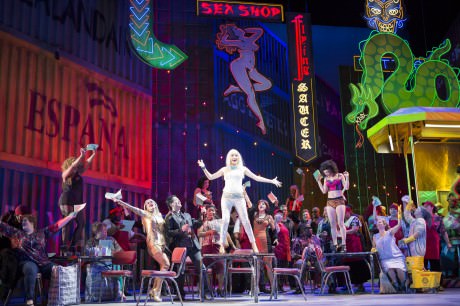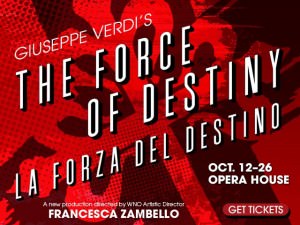Washington National Opera has mounted a provocative new production of Giuseppe Verdi’s The Force of Destiny (La Forza Del Destino) directed by WNO Artistic Director Francesca Zambello for Verdi’s 200th birthday. The libretto was written by Francesco Maria Piave based on the novel, Don Álvaro, or The Force of Fate.

WNO has not produced this for 25 years and in general it is rarely performed in the U.S. compared to Verdi’s more popular operas. She has assembled a young cast of rising stars and set the opera in a gritty, sexy urban landscape to highlight just how relevant the ancient themes of forbidden love and war, revenge and destiny are today in this country.
Leonora loves Don Alvaro who dispatches her father accidentally moments after the opera begins. They go on the run, separately seeking peace and to escape their fate with the church. Her brother Carlo pursues them to seek his revenge. The opera lives up to its epic name in the scenes outside the revenge triangle as well. Verdi highlights the common people in a gorgeous smorgasbord of life and war that makes for a counterpoint to the tense and almost simple drama of the three main characters.
From the moment you enter the theater, it’s obvious this is not a usual production. A giant screen hides the stage with a revolver and a cross painted in blood red. The unique production continues by opening with the prologue instead of the overture. The actors are onstage in silence for long minutes before the first soft chords begin. It’s a bold choice. The opera jumps a few years in act one and placing the overture between them as the characters flee is a new way to mark the time and reinforce the musical themes. It begins with three famous chords and whirls into the Leonora’s string motif that also serves as the mark of fate until her final aria at the end, complicated and beautiful and foreboding. American Maestra Xian Zhang was at the baton, another up and coming force in opera.
At act one, again the production shocks as Leonora has fled the safety of her home (and the relatively tame drawing room set) into an urban landscape that had the audience audibly gasping. Set Designer Peter Davison stacks sea containers to the rafters above and fills the stage with neon signs of a red-light district. A noodle bar dominates one side of the stage and a teeming chorus dressed by costume designer Catherine Zuber in leather, lace, sequins, and every color imaginable begins the act with the jubilant “Holà! holà! holà!” Scantily clad dancers shimmy around poles to choreography by Eric Sean Fogel. Leonora flees to a chapel marked by cement walls, graffiti, and a neon cross. Lighting designer Mark McCullough is instrumental in the gritty look and especially in the war of Act 3, which was written to occur offstage, but not in this production.
The highlight of the show is American soprano Adina Aaron (Leonora). Amber Wagner plays Leonora on select dates. Aaron’s voice is pure honey: rich, smooth and powerful. Much of the rest of the cast pales in comparison. She is undoubtedly at the beginning of a major career. The first tortured notes of her first aria “Me pellegrina ed orfana” (Exiled and orphaned far from my childhood home) are so intense, I was not sure how she was going to up her game by the end, but she does something unexpected with her character and actually brings down the intensity, which is a perfect choice for this character – a spoiled young woman who devotes her life to God and repentance. Her final aria “Pace, Pace, Mio Dio!” (Peace, peace, O my God) is indescribably beautiful.
American baritone Mark Delavan (Don Carlo) has the acting chops to match his voice and a powerful stage presence on his arias like, “Morir! Tremenda cosa” (To die! What an awesome thought) and “Le minacce, i fieri accenti” (May the winds carry off with them). In this piece without a true villain – except for destiny itself – he brings great depth to this role.
Chilean tenor Giancarlo Monsalve braves the “curse” to play Don Alvaro. Raphael Davila will take the role on select dates. In the 60s, a performer reportedly died shortly after singing “To die, a momentous thing.” Since then there are some performers who refuse the role. Monsalve thrives, particularly on his soul-tortured aria “La vita è inferno … O tu che in seno agli angeli” (Life is a hell to those who are unhappy….Oh, my beloved, risen among the angels).
Mezzo Soprano Ketevan Kemoklidze (Preziosilla) is a vision in white leather and fur, holding a machine gun as she incites the crowds to battle in “Al suon del tamburo” (When side drums rattle) and the delightful…and vocally tricky… “Rataplan, rataplan, della Gloria.”
Deborah Nansteel, Soloman Howard, and Christian Bowers (Curra, Alcade, and Army Surgeon) are all currently in training with the Domingo Cafritz Young Artist Program and are clearly on the cusp of fulfilling careers themselves.
Valeriano Lanchas (Brother Melitone), a graduate of the program, and Enrico Iori (Father Guardiano) bring a great sound to their roles and also great contrast between the pious Guardiano and the ambitious Melitone. The two sides of the church revealed in these characters are telling. Melitone calls the poor the vagabonds and wishes they would get away from him during “Fate la carità” (Give us charity), as compared to the final notes in the piece from Father Guardiano in “Non imprecare, umiliati” (Do not curse him; humble yourself), as he cries “May this death teach you faith.”

Are we all cursed? Always and only at the mercy of fate? Is the spirit a source of refuge or a prison? No one can do drama like Verdi, and setting it in a violent present underscores how vital these questions still are. Zambello takes some major risks in this production with her innovative staging, the overture, and the young cast, and they have paid off in a jaw-dropping, mind-blowing production.
Running Time: 3 hours and 10 minutes, with one 20-minute introduction.
Force of Destiny plays through October 26, 2013 at Washington National Opera at The Kennedy Center’s Opera House – 2700 F St. NW, in Washington, DC. For tickets, call the box office at (202) 467- 4600, or purchase them online.





